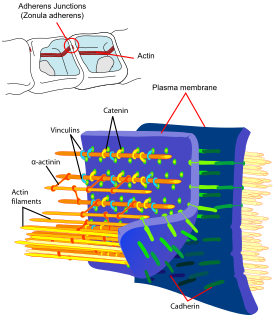Related Research Articles

Adherens junctions are protein complexes that occur at cell–cell junctions, cell–matrix junctions in epithelial and endothelial tissues, usually more basal than tight junctions. An adherens junction is defined as a cell junction whose cytoplasmic face is linked to the actin cytoskeleton. They can appear as bands encircling the cell or as spots of attachment to the extracellular matrix . Adherens junctions uniquely disassemble in uterine epithelial cells to allow the blastocyst to penetrate between epithelial cells.

Johann Gottfried Zinn was a German anatomist and botanist and was a member of the Berlin Academy.
In anatomy, fascia adherens are ribbon-like structures that stabilize non-epithelial tissue. They are similar in function and structure to the zonula adherens or adherens junction of epithelial cells. It is a broad intercellular junction in the transversal sections of an intercalated disc of cardiac muscle anchoring actin filaments. It helps to transmit contractile forces.

Zonula occludens-1 ZO-1, also known as Tight junction protein-1 is a 220-kD peripheral membrane protein that is encoded by the TJP1 gene in humans. It belongs to the family of zonula occludens proteins, which are tight junction-associated proteins and of which, ZO-1 is the first to be cloned. It was first isolated in 1986 by Stevenson and Goodenough using a monoclonal antibody raised in rodent liver to recognise a 225-kD polypeptide in whole liver homogenates and in tight junction-enriched membrane fractions. It has a role as a scaffold protein which cross-links and anchors Tight Junction (TJ) strand proteins, which are fibril-like structures within the lipid bilayer, to the actin cytoskeleton.
Terminal bar is a histological term given to the unresolved group of junctional complexes that attach adjacent epithelial cells on their lateral surfaces: the Zonula Occludens, Zonula Adherens, Macula Adherens and Macula Communicans.

Gap junction alpha-3 protein is a protein that in humans is encoded by the GJA3 gene.

Gap junction alpha-8 protein is a protein that in humans is encoded by the GJA8 gene. It is also known as connexin 50.
Epropetes is a genus of beetles in the family Cerambycidae, containing the following species:
Epropetes zonula is a species of beetle in the family Cerambycidae. It was described by Martins and Napp in 1984.
Eupromerini is a tribe of longhorn beetles of the subfamily Lamiinae.
The internal surface of the uterus is lined by uterine epithelial cells which undergo dramatic changes during pregnancy. The role of the uterine epithelial cells is to selectively allow the blastocyst to implant at a specific time. All other times of the cycle, these uterine epithelial cells are refractory to blastocyst implantation. Uterine epithelial cells have a similar structure in most species and the changes which occur in the uterine epithelial cells at the time of blastocyst implantation are also conserved among most species.
Eupromera is a genus of longhorn beetles of the subfamily Lamiinae, containing the following species:
Peltasta is a genus of moths in the family Gelechiidae.
Peltasta zonula is a moth of the family Gelechiidae. It was described by Aleksey Maksimovich Gerasimov in 1930. It is found in Uzbekistan and southern Kazakhstan.
Larazotide is a synthetic eight amino acid peptide that functions as a tight junction regulator and reverses leaky junctions to their normally closed state. It is being studied in people with celiac disease.
Eupromera disparilis is a species of beetle in the family Cerambycidae. It was described by Galileo and Martins in 1995. It is known from Brazil.
Eupromera gilmouri is a species of beetle in the family Cerambycidae. It was described by Ernst Fuchs in 1961. It is known from Brazil.
Eupromera similis is a species of beetle in the family Cerambycidae. It was described by Stephan von Breuning in 1940. It is known from Brazil.
Eupromera spryana is a species of beetle in the family Cerambycidae. It was described by Westwood in 1846. It is known from Brazil.
Anilios zonula, also known as the West Kimberley blind snake, is a species of blind snake that is endemic to Australia. The specific epithet zonula refers to the slender appearance of the species.
References
- ↑ BioLib.cz - Eupromera zonula. Retrieved on 8 September 2014.